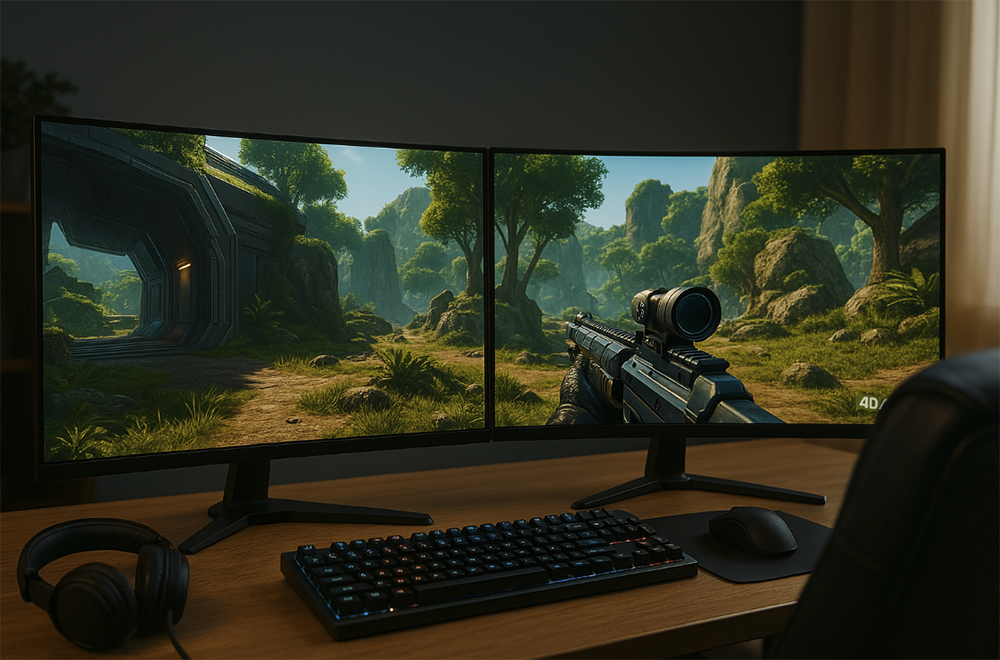Choosing between an ultra-wide monitor and a dual-monitor setup? Not so simple. Gamers in 2025 face a tough pick, especially with more demanding visuals and hardware getting serious upgrades. Add games at Instaspin casino UK and immersive sims into the mix, and it gets even trickier.
The Immersion Game: Ultra-Wide Wins on Feel
Ultra-wide monitors shine in single-screen immersion. That curved 21:9 (or even 32:9) aspect ratio wraps around your vision. No bezels. No interruptions. Just one long, fluid world stretching from left to right. Open-world RPGs, first-person shooters, or racing sims? Ultra-wide is built for that.
These screens give you a wider field of view without needing to shift your neck or eyes constantly. That translates into faster reactions in games where peripheral awareness matters. Think battle royale or fast-paced MOBAs.
Also, ultra-wides reduce clutter. No cables, no alignment headaches. Clean. Minimalist. Sharp.
But they’re not perfect. Older games may not scale well. Some UIs look stretched. And competitive esports players? They often prefer standard 16:9 for better consistency and less head movement.
Dual Monitors: More Space, More Multitasking
Want versatility? Dual monitors take the crown. One screen for the game. Another for Discord, a browser, Twitch, or your stream dashboard. Handy, right? Especially if you game and stream at once.
For certain genres, like strategy or sim games, extra screens can be gold. Imagine managing a massive city in Cities: Skylines with your map or controls on the second screen.
Dual setups also allow mixed resolutions or refresh rates. You can run a 1440p 165Hz main monitor for gaming and pair it with a 1080p secondary for chat or media.
Still, there are drawbacks:
- Bezels can break immersion
- Games don’t always support full-screen spanning
- More cables, more desk space, more power
But for multitaskers? That trade-off’s worth it.
Performance and Compatibility
This one’s important. Not all GPUs love ultra-wide resolutions. Pushing 3440×1440 or 5120×1440 takes serious horsepower. In 2025, top GPUs like the RTX 5090 or AMD’s RDNA 4 lineup handle them better, but entry or mid-tier cards might struggle.
With dual monitors, you have options. Play on your primary screen. Offload non-intensive stuff to the second. Easy. Less demanding overall, unless you try to game across both.
Some games natively support ultra-wide. Others need mods or workarounds. Dual screens? Most games default to one, so no extra steps.
Let’s break this down.
Performance pros of each setup:
Ultra-Wide:
- Seamless view, great for supported games
- One input, less setup fuss
- Higher FOV benefits competitive gameplay
Dual Monitors:
- Flexibility in usage
- Lower GPU load if gaming on one screen
- Easy multitasking without tabbing out
In short: ultra-wide is more demanding but immersive. Dual is more practical.
Ergonomics and Setup
Ergonomics aren’t just about comfort. They impact your reaction time, posture, and even gaming endurance. Let’s get real: long sessions need good gear.
Ultra-wides are simpler to set up. One mount. One screen. One cable cluster. The curve follows your eye line, making it easier to sit square and centered. Plus, less eye strain from switching between displays.
Dual monitors require more tuning. Alignment, angle, and height must match closely. Otherwise, you get weird neck tilts and posture drift. Still, with proper mounts or arms, you can dial in a great setup.
Here are 5 ergonomic tips for both setups:
- Use adjustable monitor arms for precise positioning.
- Keep top edges at or just below eye level to avoid neck strain.
- Sit at arm’s length from the screen for optimal view range.
- Ensure proper lighting to reduce glare and eye fatigue.
- Use blue light filters during night gaming sessions.
Good ergonomics don’t just feel nice—they keep you in the zone longer.
Price, Value, and Desk Space
In 2025, prices still vary wildly. Ultra-wide monitors have dropped a bit in cost, especially older 3440×1440 models. But premium ones with high refresh rates and OLED panels? Still expensive.
Dual monitors might cost less if you already own one. Just add a second. Or mix new and old. Budget setups are easier here.
But factor in stands, arms, and possibly a wider desk. That adds up.
Let’s compare some key cost-related factors:
Ultra-Wide Setup:
- Single premium monitor = $700 to $1500+
- Less clutter, fewer accessories
- Often higher quality panel (color, HDR, refresh rate)
Dual Monitor Setup:
- Two decent monitors = $500 to $1000
- Need mounts or a bigger desk
- Mix-and-match flexibility
At similar price points, ultra-wide usually delivers better image quality. Duals win on utility.

The Verdict: It Depends on Your Playstyle
No one-size-fits-all answer here. Both setups bring serious advantages. But they suit different gaming styles.
Pick ultra-wide if:
- You crave immersion
- You play open-world or cinematic games
- You want fewer distractions
Go dual if:
- You multitask while gaming
- You stream, mod, or manage multiple apps
- You want layout flexibility
Here’s a final checklist to help you decide:
Choose Ultra-Wide if:
- You have a powerful GPU
- Immersion beats utility for you
- You want a clean, minimal desk
Choose Dual Monitors if:
- You like multitasking mid-game
- You need a second screen for tools or chat
- You’re on a budget and already have one monitor
In the end, your setup should match your habits. Casual, competitive, creative—whatever your style, the right screen(s) can elevate your entire experience. Just make sure your gear keeps up with your game.







